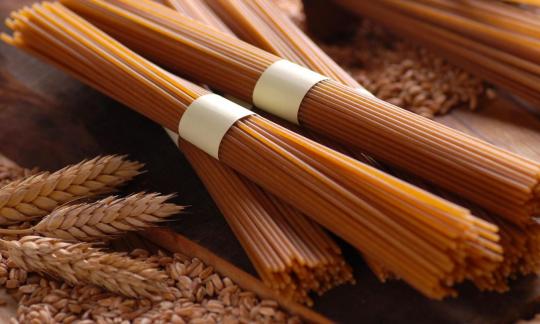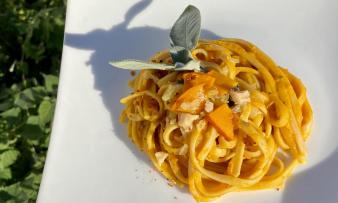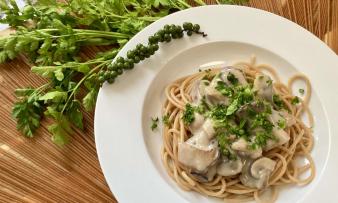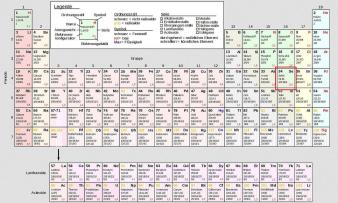Table of contents
Vegan whole wheat spaghetti (organic) is very convenient to meet your daily energy needs and maintain them for a long time. However, you should avoid eating too much of it.
Use in the kitchen
Vegan wholemeal spaghetti is extremely versatile; whether in classic Italian pasta dishes such as spaghetti bolognese (can also be prepared without meat; e.g. false bolognese with carrots, mushrooms and rhubarb) or in pumpkin and sage cream. They are also ideal for light summer pasta salads with fresh vegetables and herbs. With their nutty taste and healthy nutrients, vegan wholemeal spaghetti is an ideal choice for nutrition-conscious and delicious meals.
Ingredients
(3 portions): 250 g organic wholemeal wheat flour (type 1050), 150 g durum wheat semolina, 1 teaspoon sea salt, 160 ml water
Preparation: Mix the wheat flour, durum wheat semolina and salt in a large bowl. Then add the water and mix with a fork. You should knead the dough with your hands for an additional ten minutes - it should feel elastic but rather firm. Then cover the dough with a damp cloth and let it rest for about 30 minutes.
Roll out the dough thinly using a pasta machine or rolling pin. Cut the rolled out dough into thin strips. Carefully separate the spaghetti and let it rest on a floured surface for another 15 minutes.
Bring a large pot of salted water to the boil. Add the fresh spaghetti to the boiling water and cook until al dente, about 2-3 minutes. Fresh pasta cooks much faster than dried pasta.
Drain the cooked spaghetti and serve with your favorite sauce.
Vegan recipe(s) for smoothie with parsley
Ingredients (for 4 people): 4-5 cups of various mushrooms (e.g. oyster mushrooms and button mushrooms), 240 g walnuts, 2 tbsp olive oil (alternatively rapeseed oil), a large onion, 2 sticks of celery, 3 medium-sized carrots, 4 large garlic cloves, 1⁄2 tsp chili flakes, 1 tsp cinnamon powder, 1⁄2 tsp clove powder, 2 tbsp dried basil, 1 tbsp dried parsley, 1 bay leaf, 60 g tomato paste, 1 bottle of passata (approx. 680 ml), 300 ml water, 400 g wholemeal spaghetti (organic)
Preparation: In a blender, chop half of the mushrooms. Remove the mushrooms from the blender and repeat the process with the other half of the mushrooms. Transfer the mushrooms from the blender to a large bowl. Add the walnuts to the blender and process until finely ground. Add the ground walnuts to the bowl with the mushrooms.
In a large saucepan, heat the olive oil and add the mushroom and walnut mixture. Cook for about 6-8 minutes, stirring frequently.
Meanwhile, process the onion, celery, carrots and garlic in a blender until they form a coarse paste. Remove the mushroom and walnut mixture from the pot and transfer it to a bowl.
Now cook the onions over medium heat for about 5-6 minutes. If they stick to the bottom of the pan, add a little water little by little to loosen the browned parts.
Add the spices chili flakes, cinnamon, cloves, basil, parsley and bay leaf. Stir well and cook for another 1-2 minutes.
Push the cooked onion mixture to the sides, making room for the tomato paste. Cook for a minute. Then stir the tomato paste into the onion mixture and add the walnut-mushroom mixture to the pot.
Stir well, increase the heat and add the passata and vegetable paste. Reduce the heat to low, cover the pan and let the sauce simmer for about 25-30 minutes. While the sauce is cooking, prepare the spaghetti according to the package instructions.
Vegan recipes with whole wheat spaghetti can be found under the note: " Recipes that have the most of this ingredient ".
| Not only vegans or vegetarians should read this: Vegans often eat unhealthily. Avoidable nutritional errors. |
Purchasing - Storage
Wholemeal spaghetti (also in organic quality) is available for purchase at major retailers such as Coop, Migros, Denner, Volg, Spar, Aldi, Lidl, Rewe, Edeka, Hofer, Billa etc.
Organic supermarkets such as Denn's Biomarkt or Alnatura have wholemeal spaghetti in their range.
The availability of wholemeal spaghetti varies depending on the size of the store, catchment area, etc. If you are interested, click on our recorded food prices for the DA-CH countries (above under the ingredient image). There you will find current prices from various supermarkets and their price development.
Storage tips
It is best to store spaghetti in an airtight container in a cool place.
Ingredients - Nutritional values - Calories
One portion of spaghetti (100 g) has an energy content of 352 kcal. It contains 2.9 g of fat/100g and 14 g of protein/100g. The largest portion is carbohydrates at 73 g/100g. Of this, 9.2 g is fiber. 2
Of the micronutrients, manganese is the most abundant. 100 g of wholegrain spaghetti, at 3 mg/100 g, far exceeds the recommended daily requirement. But there is no need to worry, 11 g of manganese per day is harmless. 3 Green spelt, for example, contains a comparable amount of manganese. More manganese is contained in wholegrain rice : 100 g provide 201% of the daily requirement. 2
The second highest value in wholemeal spaghetti is selenium, at 78 µg/100g. This is a very high value and comes from the USA, but Europe has many soils that are low in selenium. Brazil nuts provide an extraordinary amount (1,917 µg/100g). About 2 nuts are enough to cover the daily requirement. 2
In third place is tryptophan (0.19 g/100g). The tryptophan content is comparable to that of buckwheat. Some seeds, such as hemp (0.37 g/100g), sunflower seeds (0.35 g/100g) orpumpkin seeds (0.58 g/100g), have higher values. 2
The complete ingredients of wholemeal spaghetti, the coverage of the daily requirement and comparison values with other ingredients can be found in our nutrient tables. In the article Nutrients explained you will get a detailed insight into the topic.
Effects on health
In general, eating whole grain pasta with a high fiber content instead of regular pasta helps reduce blood pressure, cholesterol levels, the risk of colon cancer, coronary heart disease and type 2 diabetes. In addition to the fiber, whole grain products are healthy because of the antioxidants they contain. The outer layer of the wheat grains mainly contains these valuable substances. 2,4,5,6
Whole grains have a complex composition of dietary fiber, which includes oligosaccharides (mostly fructans), resistant starch and non-starchy polysaccharides. The most important non-starchy polysaccharides are arabinoxylans, mixed β(1,3; 1,4)-D-glucans (β-glucans) and cellulose, as well as the non-carbohydrate phenolic ether lignin. The highest concentration of non-starchy polysaccharides and lignin is found in the outer cell layers of the grain; refined flour has therefore lost most of the insoluble dietary fiber components. Dietary fiber directly influences microbial composition, activity and production, as well as the molar ratios of short-chain fatty acids. 5 Short-chain fatty acids are necessary for the microbiome to keep the production of redox equivalents in the intestine in balance. 11 They also serve as an energy source for colonocytes (cells in the intestine). As a result, short-chain fatty acids improve the integrity of the intestinal barrier, glucose and lipid metabolism; they regulate the immune system, inflammatory reactions and blood pressure. 7
Durum wheat pasta is a good source of complex carbohydrates. The complex structure of the long carbohydrate chains slows down the breakdown in the body, which leads to a slower release of glucose and keeps blood sugar levels more stable. As a result, complex carbohydrates have a lower glycemic index compared to simple carbohydrates. The lower glycemic index leads to a more stable energy level and longer lasting satiety. 8.5
The health benefits of whole grains, in addition to complex carbohydrates, are most likely due to synergistic effects of the many bioactive compounds in the whole wheat grain. 12 In pasta products, researchers found fiber, oligosaccharides, phenols (phenolic acids, alkylresorcinols and flavonoids), lignans and phytic acid. Most of these health-beneficial compounds are concentrated in the outer layer and germ part of the whole grain. 8
Studies on the role of fiber in human health have shown a compelling inverse relationship between fiber intake from vegetables and whole grains and mortality. 8
It is important to note that grain products are not exclusively healthy. Most vegetables and fruits would be healthier. Grain products also contain antinutrients (eg gluten and lectins). These can, among other things, promote inflammation in the body. 9,10
Dangers - Intolerances - Side Effects
Gluten-free products currently represent a profitable segment in the food industry, with an estimated value of several billion dollars. The partially unfounded perception in the general population that a gluten-free diet is a healthy choice promotes medically unjustified eating habits regarding the avoidance of gluten. 13
Currently, only patients diagnosed with celiac disease should follow a strict gluten-free diet, and patients with an IgE-mediated wheat allergy must avoid all contact with wheat. 13 A gluten-free diet is the only available treatment for celiac disease and may also improve symptoms in non-celiac gluten/wheat sensitivity. In celiac disease, gluten triggers an immune response that leads to enteropathy (intestinal disease), malabsorption, and other symptoms. In non-celiac gluten/wheat sensitivity, the mechanism leading to symptoms is not yet fully understood. A strict gluten-free diet is necessary in celiac disease, while a gluten-reduced diet may be sufficient to control symptoms in non-celiac gluten/wheat sensitivity. Regardless of this distinction, there is an increased risk of macro- and micronutrient deficiencies when switching to a gluten-free diet or gluten-reduced diet. 14
Ecological footprint - Animal welfare
Large industries usually source their durum wheat needs from the international market, with Canada and Mexico being the main exporters. In Italy, on the other hand, the main pasta producers prefer to use durum wheat from the national market, supplementing their stocks mainly with products from France, the USA and Australia. As a result, the environmental impact of this production sector can be significant, which has led the large pasta industries to assess the environmental impact of their productions through a Life Cycle Assessment and, in some cases, even through an Environmental Product Declaration (EPD) in accordance with the standards of the International Organization for Standardization (ISO standards), making information widely available. The reasons supporting this choice are mainly based on the growing interest of final consumers in the potential environmental impact of industrial production, which has led to increasing public pressure. 15
In addition, the increased consumer interest in ancient grain varieties has led to an increase in their cultivation and use, which has led to an expansion of the product range. This has a positive impact on the protection of biodiversity and the promotion of local micro-economies. 15
A study examined the differences in the carbon footprint of two pasta production segments: traditional production with local ancient grain varieties and industrial production, which sources its grain from the world market. One kilogram of dried traditional pasta resulted in 1.706 kg CO 2 eq emissions. Conventional pasta production amounted to 1.765 kg CO 2 eq emissions per kg of dried pasta. The values are almost identical; however, the authors of this study emphasize that traditional pasta production still has a lot of room for improvement, i.e. it could achieve a smaller footprint, whereas conventional pasta production cannot. Traditional pasta also has fewer negative effects on soil degradation, agrobiodiversity, and requires fewer non-renewable resources. 15
' All you can eat for climate ', an initiative of various research and environmental organizations, gives pasta the rating 'On the goal of climate-friendly nutrition (50% better than the average)'. For pasta without eggs, they found a footprint of just 0.972 kg CO 2 eq/kg. 18
Another study suggests that the cultivation of old varieties and landraces in ecological and resource-efficient cultivation systems has great potential to reduce the environmental impact of pasta. 16
Mekonnen and Hoekstra (two very important scientists in the field of water footprint) calculated the global average water footprint of dried wheat pasta. They came up with a value of 1849 l/kg. The largest part of this is so-called green water. This is a high water consumption compared to starchy vegetables (387 l/kg); but only a fraction of meat. Rice comes in at 1673 l/kg and, together with wheat, makes up the largest part of the total water footprint in the production of crops. A "comparable" food with a much smaller footprint is the potato, for example. It only comes in at 287 l/kg. 19,20
For detailed explanations of various sustainability indicators (such as ecological footprint, CO2 footprint, water footprint), see our article: What does the ecological footprint mean?
Animal welfare - species protection
Agriculture is one of the most important factors in the rapidly increasing loss of species. After soy , wheat is the crop with the largest biodiversity footprint. This is partly due to the fact that wheat cultivation requires a lot of land. 2 1 Added to this is the use of pesticides and mineral fertilizers, which not only has drastic consequences for fauna and flora, but also for us humans. 22
Worldwide occurrence - cultivation
The first concrete information about pasta products in Italy dates back to the 13th or 14th century. Questions about their origins continue to give rise to speculation. The legend about Marco Polo's import of pasta from China probably had nothing to do with the emergence of the culinary tradition in Italy. Long before Marco Polo returned from his great voyage in 1296, the Mediterranean basin was a place for a flourishing trade in pasta products. This suggests that pasta had long been part of the diet of certain Mediterranean peoples. The Marco Polo story is probably a promotional invention by the editors of the "Macaroni Journal", the newsletter of the 'National Macaroni Manufacturers Association', an association of American pasta manufacturers. 17
Pasta has a long and fascinating history. Although the exact origin of pasta is not fully understood, it is believed that it originated simultaneously in different regions. 17
In any case, pasta gained popularity in Italy and became a staple food. Italians developed various shapes and types of pasta, and different regions of Italy have their own traditional pasta dishes. 17
Over the centuries, pasta-making techniques and traditions spread throughout Europe and eventually the world, adapting to different cultures and cuisines. Today, pasta is a popular and widespread food throughout the world, with countless variations and recipes.
Industrial production
Mixing ground wheat, water, sometimes eggs (for egg noodles or egg spaghetti) and additional ingredients depending on the recipe. These ingredients typically go into a continuous, high-capacity screw extruder machine equipped with various dies to determine the shape of the pasta. The pasta is then dried and packaged for sale. 17
The production processes involve the same mechanized operations as those found in artisanal/traditional production, with a few rare exceptions when it is necessary to manually place the finished pasta in the drying chambers. The classic sequence of processes is always the same: mixing the raw materials with water followed by bending, kneading, extrusion (or pressing) and cooling. However, while industrial manufacturers use Teflon-coated die plates, the artisanal manufacturer uses bronze die plates, which produce a rough and porous surface that is more able to absorb pasta sauces. Artisanal pasta is also, and perhaps most of all, characterized by the fact that it is dried at low temperatures (less than 45 degrees Celsius), which naturally lengthens the duration of this essential operation. This is a slow and gentle method that is particularly suitable for preserving the taste and aroma of the pasta. 17
Further information
Durum wheat (Triticum turgidum subsp. durum) is one of the most important cereals. Durum wheat is cultivated on an area of almost 17 million hectares worldwide, with a global production of 38.1 million tonnes in 2019. The largest producer is the European Union with 9 million tonnes in 2018, followed by Canada, Turkey, the United States, Algeria, Mexico, Kazakhstan, Syria and India. Durum wheat production and cultivation areas are mainly concentrated in the Mediterranean region. The Mediterranean countries are the largest importers and consumers of durum wheat products (flour, pasta and semolina). 1
Modern durum cultivars have a higher gluten index, which is associated with an improvement in pasta quality and the manufacturing process. 1
Alternative names
Sometimes spaghetti is simply called noodles or pasta. It is the same in English. 'Whole grain spaghetti' is also called 'noodles' or 'pasta'.
Spaghetti comes in different versions. The slightly thinner version is called 'vermicelli' and the flatter/wider version is called 'linguine'.
Bibliography - 21 Sources (Link to the evidence)
| 1. | Xynias IN, Mylonas I et. Durum wheat breeding in the mediterranean region: current status and future prospects. Agronomy. 2020;10(3):432. |
| 2. | US-Amerikanische Nährwertdatenbank USDA. 2019. |
| 3. | Schuchardt JP und Hahn A. Bedeutung der Spurenelemente Chrom, Mangan und Molybdän in der Ernährung des Menschen. Schweizer Zeitschrift für Ernährungsmedizin. 2011. |
| 4. | Gazza L, Nocente F. Special issue: innovative pasta with high nutritional and health potential. Foods. 2022;11(16):2448. |
| 5. | Bach Knudsen KE. Microbial degradation of whole-grain complex carbohydrates and impact on short-chain fatty acids and health. Advances in Nutrition. 2015;6(2):206–213. |
| 6. | Laddomada B, Caretto S, Mita G. Wheat bran phenolic acids: bioavailability and stability in whole wheat-based foods. Molecules. 2015;20(9):15666–15685. |
| 7. | Nogal A, Valdes AM, Menni C. The role of short-chain fatty acids in the interplay between gut microbiota and diet in cardio-metabolic health. Gut Microbes. 2021;13(1):1897212. |
| 8. | Hirawan R, Beta T. Whole wheat pasta and health. In: Wheat and Rice in Disease Prevention and Health. Elsevier; 2014: 5–16. |
| 9. | Lamothe LM, Lê KA et al. The scientific basis for healthful carbohydrate profile. Critical Reviews in Food Science and Nutrition. 2019;59(7):1058–1070. |
| 10. | de Punder K, Pruimboom L. The dietary intake of wheat and other cereal grains and their role in inflammation. Nutrients. 2013;5(3):771–787. |
| 11. | den Besten G, van Eunen K, Groen AK, Venema K, Reijngoud DJ, Bakker BM. The role of short-chain fatty acids in the interplay between diet, gut microbiota, and host energy metabolism. Journal of Lipid Research. 2013;54(9):2325–2340. |
| 12. | Liu J, Yu LL, Wu Y. Bioactive components and health beneficial properties of whole wheat foods. J Agric Food Chem. 2020;68(46):12904–12915. |
| 13. | Cabanillas B. Gluten-related disorders: Celiac disease, wheat allergy, and nonceliac gluten sensitivity. Critical Reviews in Food Science and Nutrition. 2020;60(15):2606–2621. |
| 14. | Abdi F, Zuberi S et al. Nutritional considerations in celiac disease and non-celiac gluten/wheat sensitivity. Nutrients. 2023;15(6):1475. |
| 15. | Recchia L, Cappelli A et al. Environmental sustainability of pasta production chains: an integrated approach for comparing local and global chains. Resources. 2019;8(1):56. |
| 16. | Zingale S, Guarnaccia P et al. Environmental life cycle assessment for improved management of agri-food companies: the case of organic whole-grain durum wheat pasta in Sicily. Int J Life Cycle Assess. 2022;27(2):205–226. |
| 17. | Serventi S, Sabban F. Pasta: the story of a universal food. Columbia University Press; 2002. |
| 18. | Greenpeace Schweiz, Stadt Zürich, Planted Foods AG, Branding Cuisine, Tinkerbelle, Inge, myblueplanet, ProVeg International, Dr. Earth, FightBack und Eaternity. All You Can Eatfor climate - Poster. ayce.earth. 2022. |
| 19. | Mekonnen MM, Hoekstra AY. The green, blue and grey water footprint of crops and derived crop products. Hydrol Earth Syst Sci. 2011;15(5):1577–1600. |
| 20. | Mekonnen MM, Hoekstra AY. A Global Assessment of the Water Footprint of Farm Animal Products. Ecosystems. 2012;15(3):401–415. |
| 22. | Zaller J. Unser tägliches Gift: Pestizide die unterschätzte Gefahr. 1. Auflage. Wien: Deuticke im Paul Zsolnay; 2018:116-130;146. |










Comments